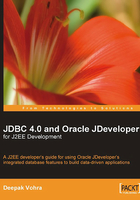
Preface
Data retrieval and storage are one of the most common components of J2EE applications. JDBC (Java DataBase Connectivity) is the Java API for accessing a Structured Query Language (SQL) relational database and adding, retrieving, and updating data in the database. JDBC 3.0 specification is the current specification implemented by most application servers. JDBC 4.0 specification became available in December 2006, but is not yet implemented by most application servers such as Oracle Application Server, WebLogic Server, JBoss Application Server, and WebSphere Application Server.
To connect with a SQL relational database, a JDBC driver is required; and most databases provide a JDBC 4.0 driver. We will use the Oracle JDeveloper 10.1.3 IDE to develop most of the J2EE applications in the book. We have chosen JDeveloper, because it includes an embedded J2EE server, the Oracle Containers for J2EE (OC4J) server, to run J2EE applications. JDeveloper also provides built-in support to connect to any of the commonly used application servers such as Oracle Application Server, WebLogic Server, JBoss Application Server, Tomcat server, and WebSphere Application Server and deploy applications to these servers. Another advantage of using JDeveloper is that JDeveloper provides built-in support for JDBC. JDeveloper also provides support for JSF; JSF user‑interface components may be selected from a component palette and added to a J2EE application.